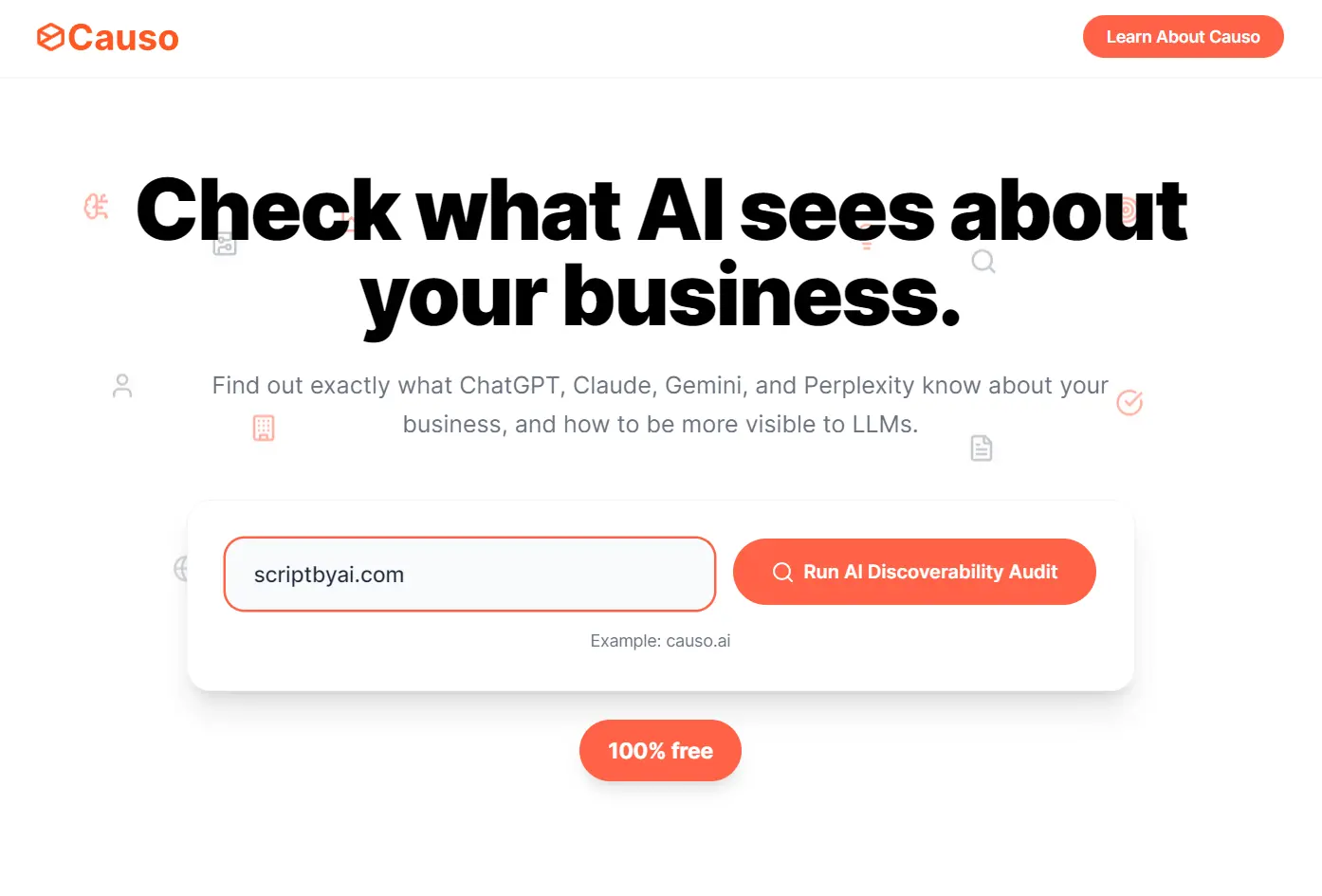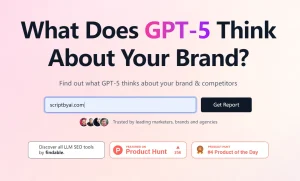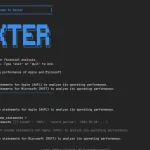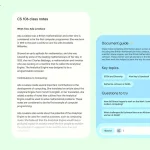AI Visibility Checker is a free generative engine optimization (GEO) tool that analyzes how ChatGPT, Claude, Gemini, and Perplexity understand and represent your startup or business.
It runs structured scans across those four major AI platforms to reveal what each model knows about your company, identify information gaps, and provide concrete recommendations to fix them.
For years, founders have been laser-focused on optimizing for Google. That’s not going away, but the front door for discovery is shifting.
People are now asking AI chatbots for recommendations, summaries, and other types of information. This tool was built to answer a simple question: Can AI correctly explain what your startup does?
It gives you a glimpse of how AI perceives your brand before a potential customer does. It’s a practical first step in what’s becoming known as Generative Engine Optimization.
Features
The AI Visibility Checker evaluates your business across multiple dimensions to give you a complete picture of your AI discoverability:
Overall Visibility Score: Generates a 0-100 rating that averages your performance across all four AI models (ChatGPT, Claude, Gemini, and Perplexity). This provides an instant snapshot of how visible your brand is in the AI ecosystem.
10-Criteria Evaluation Framework: Tests each AI model on specific dimensions, including company identity recognition, category positioning, value proposition understanding, ICP (ideal customer profile) recognition, product awareness, pricing transparency, social proof detection, geographic context, information recency, and source diversity.
Model-by-Model Breakdown: Shows individual scores for each of the four AI platforms so you can see which models understand your business well and which ones need improvement (in my test, scores ranged from 37 to 44 across different models).
Source Provenance Tracking: Reveals the exact websites, profiles, articles, and mentions that each AI model discovered when searching for your company, helping you understand where your information is coming from and where it’s missing.
Prioritized Action Plan: Delivers specific, ranked recommendations based on impact level (high, medium, low) with concrete action items you can implement immediately to improve your scores.
Strength and Weakness Analysis: Breaks down what each model got right and what it missed, so you know exactly which aspects of your business need better documentation or positioning.
How To Use It
1. Visit the AI Visibility Checker. Enter your business domain name exactly as it appears in your URL (for example, I used scriptbyai.com without the https:// prefix).
2. Click the “Run AI Discoverability Audit” button, and the platform immediately begins querying all four AI models. You’ll see a progress indicator as the system runs structured prompts through ChatGPT, Claude, Gemini, and Perplexity.
3. The initial results page displays your overall score prominently at the top (mine was 41/100) along with individual model breakdowns.

Pay attention to score variations between models since they can reveal interesting patterns. For instance, if Gemini scores you significantly higher than ChatGPT, it might mean Google's training data includes more recent information about your company.
3. Enter your email address in the form to receive the complete analysis. The full report contains detailed insights that don’t fit on the initial results screen, including the 10-criterion breakdown with specific feedback for each dimension, source provenance data showing exactly which URLs each model found, and the prioritized action plan with implementation steps.

4. Digging into the 10-criteria breakdown was where things got interesting.
The Ugly: The scores for “Pricing Awareness” (14), “Social Proof Detection” (26), and “Source Diversity” (25) were very low. This was accurate. The site has no pricing model, lacks testimonials or case studies, and has very few independent mentions.
The Good: The tool recognized my site as an AI tools directory (“Company Identity Recognition” – 54) and understood its basic function (“Category & One-Liner” – 54). Information recency was also a strong point (66), as the site is updated often.
The Bad: The report correctly pointed out that the value proposition was weak (51) and that there was no clearly defined Ideal Customer Profile (ICP) (41). The site functions more as a curated list than a distinct product, which the AI picked up on.

5. The Model Insights section showed that while all models had decent coverage, they all struggled with similar areas, primarily in recognizing the company’s identity and value proposition.
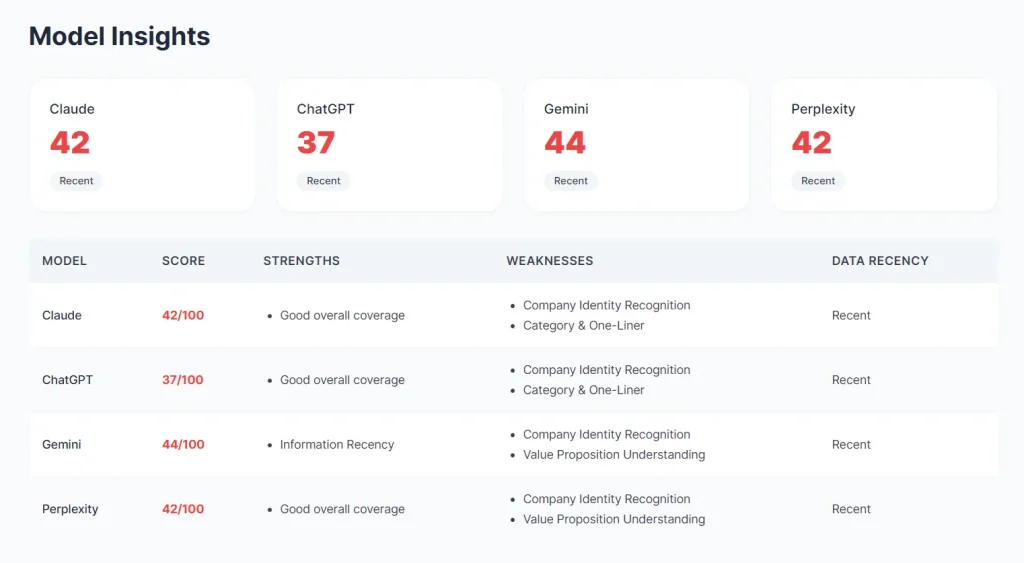
6. The most valuable part was the Recommendations section. It provided high-impact action items like “Publish Transparent Pricing and Monetization Model,” “Secure Third-Party Press Coverage,” and “Establish Clear Company Identity and ICP Definition.”

These weren’t generic suggestions. They were directly tied to the weaknesses identified in the report. For instance, to improve Source Diversity, it suggested pitching tech journalists and seeking inclusion in directories like Product Hunt, a classic, but often overlooked, strategy.
Pros
- 100% free access: No tier limitations or paywalls for the core visibility audit and report.
- Actionable recommendations: Specific, implementable advice rather than vague suggestions.
- Multi-model coverage: Simultaneous scanning across four major AI platforms provides comprehensive coverage.
- Clear scoring system: 0-100 scale with category breakdowns makes progress measurable.
- Source transparency: Shows exactly where AI found information about your company.
- Recent data emphasis: Highlights whether AI has current or outdated information about your business.
Cons
- Email requirement for full report: While the initial score is immediate, complete insights require email submission.
- No historical tracking: Single-point assessment without the ability to compare scores over time.
- Limited to four models: Doesn’t cover emerging or specialized AI systems that might be relevant to specific industries.
- Domain-only input: Can’t analyze specific subdomains or localized versions of sites.
Related Resources
- Free AI Tools for SEO: Discover more AI tools for search engine optimization.
- Free AI Tools for GEO: Discover more AI tools for generative engine optimization.
FAQs
Q: How does the AI Visibility Checker actually test what AI models know about my company?
A: The tool runs structured prompts through each of the four AI platforms (ChatGPT, Claude, Gemini, and Perplexity), asking specific questions about your business across 10 different dimensions. It queries each model with prompts like “What does [your company] do?” and “Who are the ideal customers for [your company]?” then analyzes the responses for accuracy, completeness, and source diversity.
Q: Why do different AI models show different scores for the same company?
A: Each AI platform trains on different data sources, has different knowledge cutoff dates, and uses different retrieval mechanisms. ChatGPT rely heavily on web content that’s been crawled by GPTBot, while Gemini has access to Google’s extensive search index. Claude might weigh authoritative sources differently than Perplexity, which emphasizes recent information. In my test, scores varied by 7 points between the lowest and highest model, which reflects these fundamental differences in how each system finds and evaluates information about businesses.
Q: What should I do first after receiving my visibility report?
A: Start with the high-impact recommendations that address your lowest-scoring criteria. If your Pricing Awareness score is below 20 (like mine was at 14/100), adding a clear pricing page should be your first priority since that’s a straightforward fix that immediately gives AI models concrete information to reference. Then move to items that create new citation sources, like submitting to Product Hunt or getting press coverage, since these have compounding effects across multiple criteria.
Q: How long does it take for AI models to reflect changes after I implement recommendations?
A: This varies significantly by platform and change type. New content on your website might be picked up by Perplexity within days since it crawls the web frequently, but ChatGPT could take weeks or months, depending on when its training data is updated. Press coverage tends to propagate faster because it creates multiple citation points that different models discover through various paths. Plan on re-running the audit after 30-60 days to see meaningful changes, though some improvements might appear sooner.
Q: Can I use this tool to check competitors and compare our visibility?
A: The tool doesn’t have a built-in competitor comparison feature, but you can manually run audits for competitor domains to see how they score. This approach is useful for understanding what “good” looks like in your space and identifying gaps where competitors have better AI visibility than you. Just be aware that directly comparing overall scores isn’t always apples-to-apples since scoring factors might weight differently for different business models (B2B vs B2C, for example).
Q: What’s the difference between AI visibility and traditional SEO?
A: Traditional SEO optimizes for appearing in search engine results pages (SERPs) when people type specific keywords. AI visibility optimizes for being correctly understood and recommended when people ask conversational questions to AI assistants. While there’s overlap in tactics (quality content, authoritative backlinks), AI visibility requires more focus on structured information, clear positioning, social proof, and source diversity since AI models synthesize information from multiple sources rather than just ranking pages by keywords.
